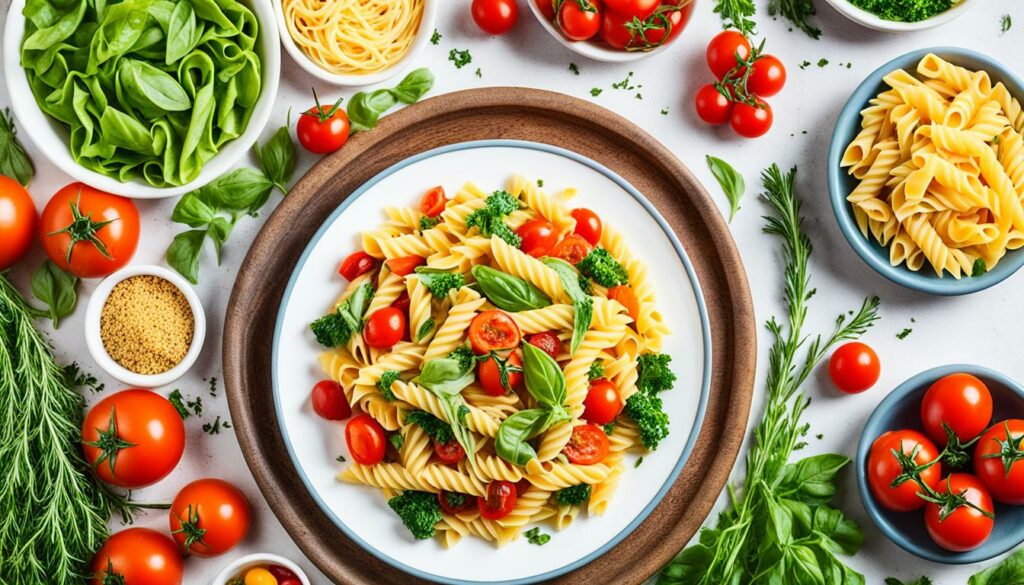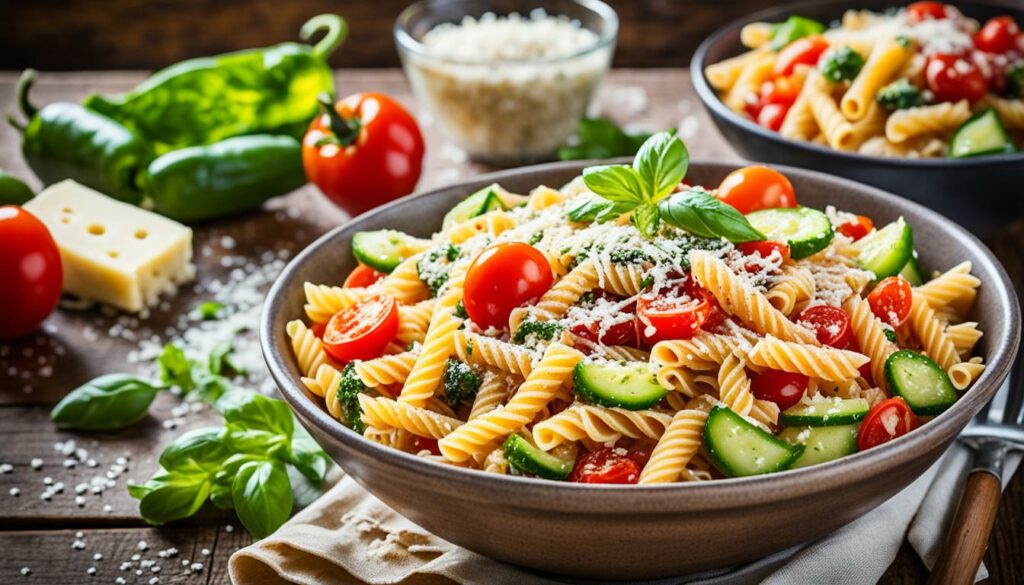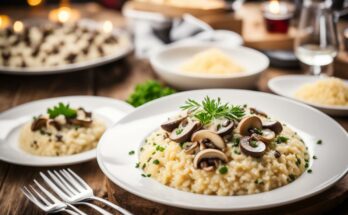Are you wondering which pasta is the healthiest choice for your diet? Look no further! In this article, we will explore the top pasta options that are not only delicious but also packed with nutrients to support your overall health.
Registered dietitian Jamie Nadeau advises that the healthiest pasta options in terms of nutrition are chickpea pasta and whole grain pasta. These varieties offer an excellent balance of protein and fiber, making them ideal choices for a healthy and well-rounded diet.
Key Takeaways:
- Chickpea pasta and whole grain pasta are the healthiest pasta options.
- These varieties are rich in protein and fiber, which are essential for a balanced diet.
- Incorporating chickpea pasta or whole grain pasta into your meals can enhance the nutritional profile of your dishes.
- Adding these pasta options to your diet can help improve digestion and stabilize blood sugar levels.
- Remember to pair your pasta with other nutritious ingredients, such as vegetables, lean proteins, and healthy fats, to create a well-rounded meal.
The Nutritional Profiles of Pasta Types
When it comes to the nutritional profiles of pasta, both chickpea pasta and whole grain pasta offer impressive health benefits.
Chickpea Pasta Nutrition
Chickpea pasta is a fantastic source of protein and fiber. In just a 2-ounce serving, it provides a whopping 11 grams of protein and 8 grams of fiber. This makes it an excellent choice for those looking to increase their daily protein intake and promote healthy digestion. Additionally, the high fiber content in chickpea pasta can help stabilize blood sugar levels.
Whole Grain Pasta Nutrition
Whole grain pasta is another nutritious option. It contains 8 grams of protein and 7 grams of fiber per 2-ounce serving. With its combination of protein and fiber, whole grain pasta can help you feel satisfied and energized for longer periods. The fiber in whole grain pasta is especially beneficial for digestion and can contribute to improved gut health.
Both chickpea pasta and whole grain pasta provide a balanced blend of carbohydrates, fiber, and protein, making them great additions to a healthy diet. Consuming these pasta varieties can enhance the nutritional content of your meals and support overall wellness.
| Pasta Type | Protein | Fiber |
|---|---|---|
| Chickpea Pasta | 11 grams | 8 grams |
| Whole Grain Pasta | 8 grams | 7 grams |
The Health Benefits of Pasta
Contrary to popular belief, pasta can be a part of a healthy diet. Carbohydrates, like those found in pasta, are essential for providing energy. The World Health Organization recommends that carbohydrates come from whole grains, fruits, vegetables, and legumes.
While whole grain pasta is a good option that aligns with this recommendation, regular pasta can still be included in a balanced meal when paired with protein, healthy fats, and fiber-rich ingredients.
Fiber, which is found in whole grain and legume-based pasta, can help slow down digestion and stabilize blood sugar levels.

| Health Benefits of Pasta | Importance in a Healthy Diet | Role in Blood Sugar Stabilization |
|---|---|---|
| Pasta provides essential carbohydrates for energy | Pasta can be included in a balanced meal when paired with protein, healthy fats, and fiber | Fiber in pasta helps slow down digestion and stabilize blood sugar levels |
| Pasta options like whole grain and legume-based varieties offer additional nutrients and fiber | Whole grain pasta aligns with recommendations from the World Health Organization | Stable blood sugar levels can contribute to better overall health and energy levels |
Exploring Whole Grain Pasta
When it comes to making healthy choices for pasta, whole grain pasta stands out for its numerous benefits and higher nutritional value compared to regular pasta made from refined flour. Unlike refined flour pasta, whole grain pasta retains the entire grain kernel, including the germ, bran, and endosperm. This means that it contains more fiber, B vitamins, and protein, making it a nutritious option to incorporate into your diet.
Whole grain pasta offers a host of health benefits, including:
- Higher fiber content: Whole grain pasta is rich in dietary fiber, which aids in digestion, promotes satiety, and supports healthy blood sugar levels.
- Greater nutrient profile: Compared to refined flour pasta, whole grain pasta contains a variety of vitamins and minerals essential for overall health and well-being.
- Improved heart health: The fiber content in whole grain pasta is linked to a reduced risk of heart disease and improved cardiovascular health.
- Weight management support: The higher fiber and protein content in whole grain pasta can help you feel fuller for longer, aiding in weight management and promoting a healthy body weight.
To better illustrate the nutritional value of whole grain pasta, let’s compare it to regular pasta made from refined flour:
| Refined Flour Pasta | Whole Grain Pasta | |
|---|---|---|
| Protein per 2-ounce serving | 5 grams | 8 grams |
| Fiber per 2-ounce serving | 2 grams | 7 grams |
| Vitamins and Minerals | Minimal | Rich source due to the presence of the germ and bran |
As you can see, whole grain pasta delivers significantly more protein and fiber per serving, as well as an array of vitamins and minerals compared to its refined flour counterpart.
By choosing whole grain pasta, you can enjoy a delicious and satisfying meal while supporting a balanced and nutrient-rich diet.

Exploring Chickpea Pasta
Chickpea pasta is a popular legume-based alternative to traditional pasta. It offers a variety of benefits, including its nutritional value, protein content, and neutral flavor. Compared to regular pasta, chickpea pasta packs a powerful nutritional punch.
One of the key advantages of chickpea pasta is its high protein content. With approximately X grams of protein per serving, it serves as an excellent plant-based protein source for individuals following vegetarian or vegan diets. Protein is essential for muscle growth and repair, as well as overall bodily functions.
In addition to protein, chickpea pasta is also a great source of dietary fiber. Each serving contains X grams of fiber, which aids in digestion and promotes feelings of fullness. Incorporating fiber-rich foods into your diet can help support a healthy digestive system and regulate blood sugar levels.
Neutral Flavor and Versatility
One of the standout features of chickpea pasta is its neutral flavor. Unlike some other legume-based pastas that may have a distinct taste, chickpea pasta offers a mild flavor profile. This makes it incredibly versatile, as it can be paired with a wide range of sauces and ingredients.
Whether you prefer a classic marinara sauce, a creamy alfredo, or a zesty pesto, chickpea pasta can complement any flavor combination. It provides the perfect canvas for showcasing your favorite pasta dishes while adding a nutritional boost.
“Chickpea pasta offers a neutral flavor that works well with a variety of sauces and ingredients. It’s a versatile option for creating delicious and nutritious meals.” – Jamie Nadeau, Registered Dietitian
The Nutritional Value of Chickpea Pasta
To better understand the nutritional value of chickpea pasta, let’s take a closer look at its key components:
| Nutrient | Amount Per Serving (2 oz) |
|---|---|
| Protein | X grams |
| Fiber | X grams |
| Carbohydrates | X grams |
| Fat | X grams |
| Iron | X% of Daily Value |
| Calcium | X% of Daily Value |
Chickpea pasta’s impressive nutritional profile makes it a smart choice for those seeking a well-rounded and nourishing meal.
As demonstrated, chickpea pasta provides a healthy dose of protein, fiber, and essential nutrients. Its neutral flavor and versatility make it an ideal option for individuals looking to enjoy the benefits of legume-based pasta without compromising on taste.
Other Healthy Pasta Options
In addition to chickpea pasta, there are other healthy pasta options made from legumes. Lentil pasta and black bean pasta are two popular alternatives. These pasta varieties offer protein, fiber, and various nutrients, making them excellent choices for a balanced and nutritious meal.
Lentil pasta is a pasta made from legumes, specifically red or green lentils. It is rich in protein, containing around 13 grams of protein per 2-ounce serving. Lentil pasta also provides a good amount of dietary fiber, with about 7 grams per serving. This combination of protein and fiber makes lentil pasta a satisfying option that can help keep you full and regulate your digestion.
Black bean pasta, as the name suggests, is pasta made from black beans. It is a great source of plant-based protein, with approximately 25 grams of protein per 2-ounce serving. Black bean pasta is also high in fiber, delivering around 12 grams per serving. Incorporating black bean pasta into your meals can be a fantastic way to boost your protein intake and add variety to your diet.
Both lentil pasta and black bean pasta are gluten-free options, which makes them suitable for individuals with gluten sensitivities or those following a gluten-free diet. They are also rich in antioxidants, vitamins, and minerals, providing additional health benefits.
“Lentil pasta and black bean pasta are nutritious alternatives to traditional pasta. They offer a balance of protein, fiber, and other essential nutrients, making them an excellent choice for plant-based pasta options. Try incorporating lentil pasta or black bean pasta into your meals for a flavorful and nourishing experience!”
| Pasta Type | Protein per 2-Ounce Serving | Fiber per 2-Ounce Serving | Gluten-Free |
|---|---|---|---|
| Lentil Pasta | 13 grams | 7 grams | Yes |
| Black Bean Pasta | 25 grams | 12 grams | Yes |
Cooking Tips and Recommendations
Cooking whole grain and chickpea pasta requires some adjustments compared to regular pasta. Here are some tips and recommendations to help you achieve the best results:
1. Follow the Instructions
When cooking whole grain or chickpea pasta, it’s important to read and follow the instructions on the package. Cooking times may vary depending on the brand and type of pasta.
2. Don’t Overcook
To maintain the desired texture and consistency of your pasta, avoid overcooking it. Whole grain and chickpea pasta can become mushy if cooked for too long. Keep an eye on the cooking time and check for doneness by tasting a noodle.
3. Rinse in a Colander
After cooking the pasta, rinse it in a colander under cold water. This helps remove excess starch and prevents the pasta from sticking together. Rinsing also helps preserve the texture of the pasta.
4. Pair with Flavorful Sauces
When cooking chickpea pasta, pair it with flavorful sauces to enhance its taste. Chickpea pasta has a neutral flavor, making it a great canvas for various sauce options. Try tomato-based sauces, pesto, or creamy sauces to add a burst of flavor to your pasta dish.
5. Experiment with Brands and Cooking Methods
Every brand and type of pasta may have slight variations in cooking time and texture. Experiment with different brands and cooking methods until you find the perfect balance for your taste. Some brands may require slightly shorter or longer cooking times, so don’t be afraid to try different options.
By following these cooking tips and recommendations, you can ensure that your whole grain and chickpea pasta turns out delicious and maintains its ideal texture. Enjoy experimenting with different flavors and finding your favorite combinations!
Conclusion
In conclusion, when it comes to choosing the healthiest pasta options, chickpea pasta and whole grain pasta emerge as the top contenders. These pasta varieties excel in their high protein and fiber content, making them excellent choices for individuals looking to maintain a balanced diet and optimize their health.
Incorporating chickpea pasta and whole grain pasta into your meals can significantly enhance the nutritional profile of your diet. With their considerable protein and fiber content, these pasta options provide essential nutrients while promoting satiety and aiding digestion. By including these healthier pasta alternatives, you can enjoy a satisfying and nourishing dining experience.
However, remember to consider your personal taste preferences and explore different brands to find the pasta that suits you best. While chickpea pasta and whole grain pasta are highly recommended for their health benefits, finding the right one for you will ensure a more enjoyable culinary experience. Additionally, ensure that you balance your pasta meals with other nutritious ingredients, such as vibrant vegetables, lean sources of protein, and healthy fats, to maintain a well-rounded and wholesome diet.
Delicious Calamarata Pasta Recipe – A Taste of Italy at Home
FAQ
Which pasta is the healthiest?
The healthiest pasta options in terms of nutrition are chickpea pasta and whole grain pasta.
What are the nutritional profiles of chickpea pasta and whole grain pasta?
Chickpea pasta is protein-packed and fiber-rich, containing 11 grams of protein and 8 grams of fiber per 2-ounce serving. Whole grain pasta offers 8 grams of protein and 7 grams of fiber in a 2-ounce serving.
What are the health benefits of pasta?
Pasta provides essential carbohydrates for energy. Whole grain and legume-based pastas also offer fiber, which aids in digestion and stabilizes blood sugar levels.
What are the benefits of whole grain pasta?
Whole grain pasta contains the entire grain kernel, including the germ, bran, and endosperm. This means it retains more fiber, B vitamins, and protein compared to refined flour pasta. It provides a balanced and nutrient-rich addition to your diet.
What are the benefits of chickpea pasta?
Chickpea pasta is a plant-based protein source that is high in fiber. It offers 11 grams of protein and 8 grams of fiber per 2-ounce serving. It has a neutral flavor and can be easily paired with different sauces.
Are there any other healthy pasta options?
Yes, options like lentil pasta and black bean pasta are made from legumes and offer protein, fiber, and various nutrients.
What are some cooking tips for healthy pasta?
Follow the instructions on the package, avoid overcooking, and rinse the pasta in a colander to remove excess starch. When cooking chickpea pasta, pair it with a flavorful sauce to enhance its taste.
What is the summary of the healthiest pasta options?
Chickpea pasta and whole grain pasta are protein-packed and fiber-rich choices that provide a balanced combination of carbohydrates, fiber, and protein. Incorporating these pasta varieties into your meals can enhance the nutritional content and offer a satisfying dining experience.




